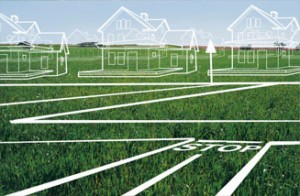Subdividing – the process of dividing one parcel of land into a number of parcels – is a process regulated by local municipalities and, at times, a number of other state agencies.
Typically, local municipalities have subdivision regulations which require the review of a proposed subdivision by the local Planning Board. The Planning Board will review the subdivision to make sure that there is adequate water supply, sewage disposal facilities, vehicular and emergency vehicle access, and generally ensure that the proposal represents sound planning for the community. A wide variety of conditions may need to be met to satisfy the local subdivision regulations. For most subdivisions, it will be necessary to perform percolation tests check for the ability to construct septic systems, minimum lot areas and road frontages will be required, etc. Larger subdivisions may need well flow tests to demonstrate adequate water quantity and quality, traffic studies to ensure that there will be no negative impacts to local traffic patterns, or an analysis of the affects of the subdivision on stormwater runoff. For some large subdivisions, it may even be necessary for an Environmental Impact Statement (EIS) to be prepared. An EIS is a lengthy analysis of a wide variety of possible impacts of a project, which may include air and water quality, visual impacts, archaeological studies, or even an assessment of whether or not local schools have the capacity for additional families.
Approvals from other agencies may also be required. If a new road is planned for the subdivision, approval for the new intersection will be required from the appropriate local or state agency. If the subdivision is in the New York City watershed, approvals from the NYC Dept. of Environmental Protection may be necessary. New York State Department of Health approvals may be needed for a number of reasons, including sewage disposal, water supply, or if the subdivision is a “realty subdivision” – a subdivision involving five or more parcels of less than five acres. Other agencies, such as the New York State Department of Environmental Conservation, the US Army Corps of Engineers, etc., may also be involved.
The planning and approval process for a subdivision can range from simple to complex. Typically, a subdivider will need to hire a licensed surveyor and licensed engineer to prepare the necessary plans and perform the necessary tests and analyses. Once the plans are prepared, a “sketch plan” is submitted to the Planning Board for initial review. After modifying the sketch plan as needed based on the initial comments from the Planning Board, a “preliminary plan” is submitted. After submission of the preliminary plan, there is often a public hearing held at which the public is invited to ask questions and make comments on the proposed subdivision. Further modifications to the plan may then be needed before final planning board approval is obtained.
Local Planning Boards typically meet once or twice per month. The time needed to obtain an approved plan may range from two or three months for smaller subdivisions up to many months (or even years) for very large projects. A town clerk would be able to give a general time frame for small projects. An engineering firm familiar with local regulations and approval processes would be able to give an estimated timeframe for larger projects.





